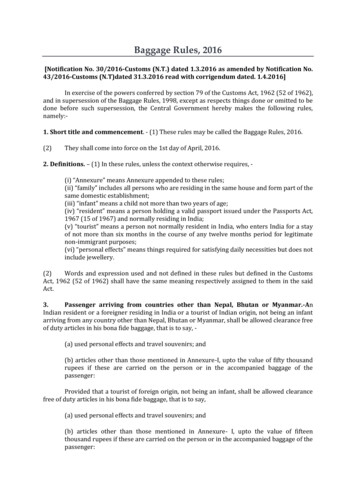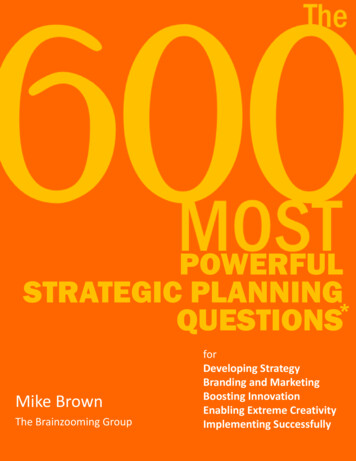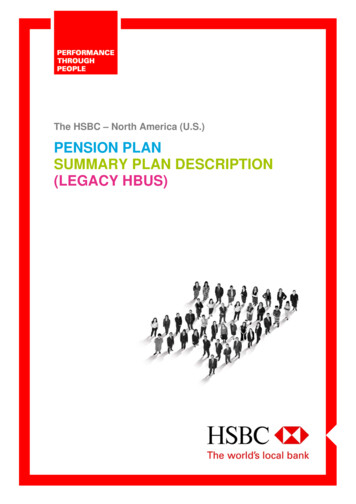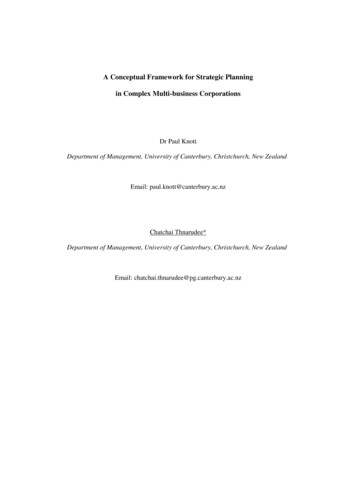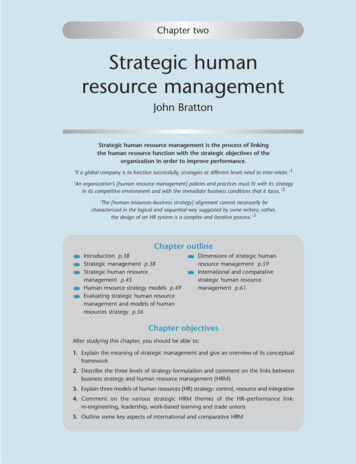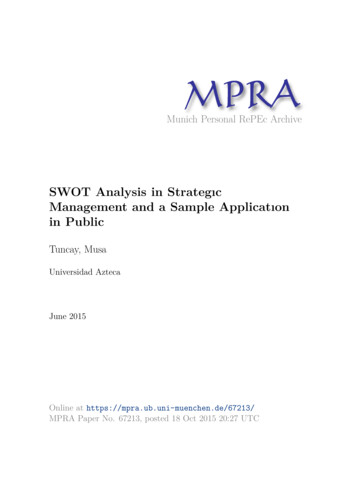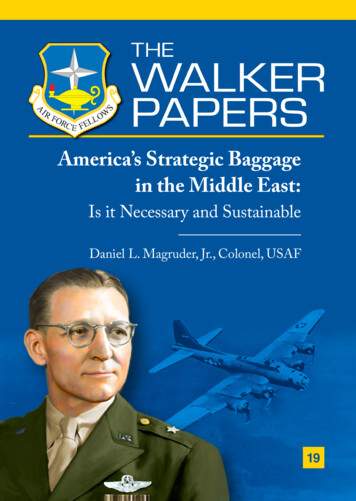
Transcription
America’s Strategic Baggagein the Middle East:Is it Necessary and SustainableDaniel L. Magruder, Jr., Colonel, USAF
AIR UNIVERSITYAIR FORCE FELLOWSAmerica’s Strategic Baggage inthe Middle East:Is it Necessary and SustainableCol Daniel L. Magruder, Jr., usafWalker Paper No. 19Air University PressAcademic ServicesMaxwell Air Force Base, Alabama
Director, Air University PressDr. Mehmed AliAccepted by Air University Press May 2021 and published August 2021Project EditorDr. Achala Gunasekara-RockwellIllustratorDaniel ArmstrongPrint SpecialistMegan N. HoehnAir University Press600 Chennault Circle, Building 1405Maxwell AFB, AL Twitter: https://twitter.com/aupressDisclaimerOpinions, conclusions, and recommendations expressed or impliedwithin are solely those of the author and do not necessarily represent the views of the Department of Defense, the Department ofthe Air Force, the Air Education and Training Command, the AirUniversity, or any other US government agency. Cleared for publicrelease: distribution unlimited.This Walker Paper and others in the series are available electronically at the AU Press website: pers/Air University Press
Air Force FellowsSince 1958 the Air Force has assigned a small number of carefully chosen,experienced officers to serve one-year tours at distinguished civilian institutions studying national security policy and strategy. Beginning with the 1994academic year, these programs were accorded senior service school professional military education in-residence credit. In 2003 these fellowships assumed senior developmental education (SDE), force development credit foreligible officers.The SDE-level Air Force Fellows serve as visiting military ambassadors totheir centers, devoting effort to expanding their colleagues’ understanding ofdefense matters. As such, candidates for SDE-level fellowships have a broadknowledge of key Department of Defense (DOD) and Air Force issues. SDElevel fellows perform outreach by their presence and voice in sponsoring institutions. SDE-level fellows are expected to provide advice, promote, andexplain Air Force and DOD policies, programs, and military doctrine strategy to nationally recognized scholars, foreign dignitaries, and leading policyanalysts. The Air Force Fellows also gain valuable perspectives from the exchange of ideas with these civilian leaders. SDE-level fellows are expected toapprise appropriate Air Force agencies of significant developments andemerging views on defense and economic and foreign policy issues withintheir centers. Each fellow is expected to use the unique access she or he has asgrounds for research and writing on important national security issues. TheSDE Air Force Fellows include the National Defense Fellows, the RAND Fellows, the National Security Fellows, and the Secretary of Defense CorporateFellows. The Air Force Fellows program also supports a post-SDE militaryfellow at the Council on Foreign Relations.On the intermediate developmental education level, the chief of staff approved several Air Force fellowships focused on career broadening for AirForce majors. The Air Force Legislative Fellows was established in April 1995with the Foreign Policy Fellowship and Defense Advanced Research ProjectsAgency Fellowship coming under the Air Force Fellows program in 2003. In2004 the Air Force Fellows also assumed responsibility of the National Laboratories Technologies Fellows.iii
ContentsAir Force Fellows iiiAbout the Author viAbstract viiAcknowledgements viii1 Introduction 13Notes 2 Strategic Baggage 4What Is Strategic Baggage? Why Does Strategic Baggage Matter Now? Notes 3 US Interests and Military PresenceNecessary and Sustainable? US Interests: Post–World War II to Today US Military Presence in the Middle East IsNecessary and Sustainable US Military presence in the Middle East Is NeitherNecessary Nor Sustainable Notes 4 Assessing Total Costs 4589911121517Total Costs and Risks in Sustaining Strategic Baggagein the Middle East Tangible Costs Societal Costs: Inequity, Shared Sacrifice, Accountability Opportunity Costs–Constraining Choice Notes 5 Short- and Long- term Strategic Trades Strategic Trades—Readiness, Capability, and Capacity Readiness—People, Ideas, and Things Capability—Underwriting Credible,Conventional Deterrence iv171721232630303035
Capacity—Imbalance and Stress on the Force: Notes 6 Risks of Long- term Military Presence Risks—Dealing with the Inevitable Unintended Consequences Mission Creep Inadvertent Escalation Risk of Doing Nothing Strategic Solvency Notes 7 Conclusion 363841414142434344444648Notes v
About the AuthorColonel Daniel L. Magruder Jr. is the Strategic Plans Division Chief at AirForce Special Operations Command. He received his commission from theUnited States Air Force Academy in 2003. As a Special Tactics Officer, he hasled special operations forces in multiple deployments during Operations Enduring Freedom, Iraqi Freedom, Willing Spirit, Freedom’s Sentinel, and Inherent Resolve. Colonel Magruder has served in staff positions as a Weapons andTactics officer, in operations at Special Operations Command Central, and asthe lead speechwriter to the Chief of Staff of the Air Force. He completed hisdoctorate in political science at the University of Chicago and has numerouspublications, including the book, Counterinsurgency, Security Forces, and theIdentification Problem: Distinguishing Friend from Foe.vi
AbstractIs U.S. military presence in the Middle East sustainable at current levels?Troop levels are low in individual war zones, casualties are rare, and the fiscalcost is a bargain by historical standards. However, these estimates do not takeinto account strategic baggage accrued over the last two decades of sustainedengagement in the region. Baggage is not just the weight of commitments ofthe past, but also the inability to let it go. The sustained presence in the regionlimits choices impacting current readiness and future defense strategy.A more comprehensive analysis of U.S. military commitments to the MidEast is achieved using a framework of analysis to evaluate perceived benefits,costs, and risks over time. This tally would include a wider scope of costs:tangible, societal, and forgone opportunities. The main opportunity costs arethe strategic trade-offs between sustaining current overseas requirementsand preparing a force for the future. In terms of developing and executing adefense strategy, the tension plays out during dialogue about readiness, capability, and capacity. National security leaders articulate pros and cons oftrade-offs to identify the most consequential decisions about risk tolerance.Finally, maintaining baggage incurs risks in terms of unintended consequences, mission creep, potential for inadvertent escalation, and may lead tostrategic insolvency.The nation is at an inflection point given the evolving world order and erosion of U.S. military advantages. To prepare for the future the U.S. militarycannot replace hard-nosed analysis with hope and delay tough choices. A superpower should be able to sustain its posture in the Middle East, but also beforthright about the true costs to Americans and impacts on future readiness.The U.S. should find ways to jettison or minimize strategic baggage in the Middle East in order to devote more time and resources to invest in the future.vii
AcknowledgementsThis paper would not have been possible without the help of many people.First and foremost, I owe an appreciation to the Air Force and American public to support a year of reflection. The Brookings Institution was a wonderfulintellectual home. I must admit the idea for this line of research was not myown. Dr. Mara Karlin planted the seed in a seminar in 2019 and I finally gotaround to writing about it. I also thank the many unnamed folks who discussed my ideas, challenged me, and ultimately made me a better leader. Thepoint of this year is to depart with a better understanding of how to use military power responsibly—and to give voice to those we lead.I spent most of the time this past year with those closest to me. Jen, yougive meaning to my life and I am glad I spent the majority of time this yearwith you. Maverick and Makenna, you are the future and my only hope is thatyou continue to reach for the stars.Daniel L. Magruder Jr.Alexandria, Virginiaviii
Chapter 1IntroductionA main challenge facing national security policy makers in the MiddleEast is how to reduce ambitions and military commitments to sustainablelevels. How do the United States and its partners cost- effectively stabilize theregion, deter Iran, and counter violent extremists? These are challenges thatmust be balanced against the structural changes in the international order.All the while, America’s military capabilities that underwrite conventionaldeterrence are eroding. While the United States is a global power with globalresponsibilities, the National Defense Strategy Commission warned aboutthe “growing tendency to conflate the stating of desired objectives with thewherewithal to accomplish them.”1A superpower should be able to sustain its posture in the Middle Eastuntil acceptable political objectives are met. Troop levels are low in individual war zones, casualties are rare, and the fiscal cost is a bargain by historicalstandards. However, these estimates do not consider strategic baggage accrued over the past two decades of sustained engagement in the region. And,while it is entirely possible the United States could sustain this level of effort,it does not mean it increases American security or prosperity.The paper defines strategic baggage and analyzes whether it is necessaryand sustainable. The analysis recognizes a need for military presence and doesnot advocate abandoning US interests in the region—or the majority of themilitary presence. The study addresses arguments supporting the necessity ofUS military presence while emphasizing the hidden costs of strategic baggage. Baggage is not just the weight of commitments of the past but also theinability to let it go. This paper argues the sustained presence in the regionlimits choices impacting current readiness and adapting to future threats.A more comprehensive analysis of US military commitments to the Middle East can better evaluate perceived benefits, costs, and risks over time.While holding benefits of military presence constant, this tally would includea wider scope of costs: tangible, societal, and forgone opportunities. The mainopportunity costs are the strategic trade- offs between sustaining currentoverseas requirements and preparing a force for the future. In terms of developing and executing a defense strategy, the tension plays out during dialogueabout readiness, capability, and capacity. National security leaders articulatepros and cons of trade- offs to identify the most consequential decisions aboutrisk tolerance. Finally, maintaining baggage incurs risks in terms of unin1
tended consequences, mission creep, and potential for inadvertent escalationand may lead to strategic insolvency.Most debates about US military presenceare not productive due to the fact analysts begin from vastly differing startingpoints. Fundamental assumptions turn on how broadly an analyst defines interests and values—and a corresponding willingness to commit military resources to secure them. The same minimal/maximal lens applies to one’s toleration of risks. Of course, individuals view interests, values, risk, and desireto use force on a sliding scale. Therefore, one’s fundamental assumptions andworldview may obviate any possibility to persuade. This explains how analystsarrive at different conclusions based on the same set of facts.This study aims to give an accurate diagnosis rather than a perfect prescription. The nation is at an inflection point, given the evolving world orderand erosion of US military advantages. While the urgency of the threat is debatable, to prepare for the future, the US military cannot replace hard- nosedanalysis with hope and delay tough choices. The United States should findways to minimize strategic baggage in the Middle East to devote more timeand resources to invest in the future. This type of study comes with intellectual and professional risk but, as Andy Marshall was fond of saying, “I’d ratherhave decent answers to the right questions than great answers to irrelevantquestions.”2 For example, is America’s strategic baggage in the Middle Eastnecessary and sustainable at current levels? Have American actions in theregion furthered our interests or undermined them? How does the UnitedStates sustain security commitments in the Middle East while adapting tocompete with peer adversaries? What are the challenges that inhibit changeand opportunities to gain a competitive advantage over rivals?This paper will be unsatisfactory to many. It does not present an elegantcausal theory or bold policy prescriptions. Instead, I employ the concept ofstrategic baggage to gain new insights into the impacts of sustained militarycommitments to the Middle East. Admittedly, the framing of the subject as“baggage” could bias analysis. This is not the intent. The intent of the study isto capture the second- and third- order costs and trade- offs that are often assumed away. Over time, these costs and trade- offs have positive and negativeimpacts. Second, the traditional consensus is well- trodden ground that hasvast support from academic and policy circles. While there are few remaininggaps in knowledge, there might be errors in the traditional paradigms employed to analyze costs and benefits. Recognizing benefits of US militarypresence, analysis should scrutinize, perhaps being more critical of sustainedengagement, while the world order has evolved.2
Notes1. Andrew Krepinevich and Barry Watts, The Last Warrior (New York: BasicBooks, 2015), 252.2. Krepinevich and Watts, The Last Warrior, xxii.3
Chapter 2Strategic BaggageWhat Is Strategic Baggage?Strategic baggage is a military commitment that has outlasted its utility. Thisoccurs when, on balance, the perception of the costs is either too high, benefitstoo low, or risks too great to continue. Once decisions are made to commitmilitary forces, you cannot wind back the clock. Choices about military engagement are often considered in isolation rather than as one part of a cumulative series of commitments. There are problems with this approach because,taken in isolation, a military engagement may seem logical, feasible, and sustainable. However, when the United States accepts multiple open- ended commitments without reducing promises elsewhere, the military runs the risk ofoverstretch as these commitments add up over time.It is important to explain how and when a military commitment outlasts itsutility. There are different types of military commitments that connect militaryoperations to foreign- policy objectives: routine security activities, small- andlarge- scale interventions. Routine activities are those which the Pentagon conducts with partners and allies through security cooperation programs. Thepurpose of this type of activity is to “advance U.S. national security and foreign- policy interests by building the capacity of foreign security forces to respond toshared challenges.”1 Second, small- scale intervention is typified by a relativelysmall footprint of US military personal working by, with, and through partnersand allies. Finally, large- scale interventions are those with Americans decisivelyengaged in combat operations—such as the peak years of intervention in Iraqand Afghanistan. Through the execution of military operations in varying scenarios and contexts, the calculus of costs and risks change over time in relationto whether policy goals are achieved. When goals are not achieved at an acceptable cost or risk, a military commitment has outrun its course.The perpetuation of baggage is due to privileging the short- term objectivesover long- term ones. There are good reasons why this is so. First, it is easier tomaintain the status quo than to make a big change based on an uncertainprojection of the future. Similarly, political leaders have a bias for action anddo not typically like to incur risks. This helps explain why no twenty- first–century president has ended a war they began. As Chris Brose argued, politicsalso helps explain why there is a “systemic failure in our defense establishment” to recognize trends and adjust.2 He continued to explain the dynamic4
makes it incredibly difficult to retire legacy platforms that carry lucrative sustainment contracts ensuring years of profits for defense contractors.A second reason strategic baggage is perpetuated is because the military isa can- do organization. Despite shortcomings in achieving some strategic objectives, the US military consistently appeals for patience. This can be underthe guise of allowing a partner to build on progress, create political trade- space, or extend time horizons.3 This is understandable, but at what point doshort- term decisions aggregate into long- term baggage—5, 10, 20 years? Theflip side is decision- makers cannot completely erase the consequences ofpast choices. However, a decision to maintain the status quo reduces opportunities to use those same forces for other purposes. For example, considerthe squadrons, companies, and battalion of special operators required tomaintain a presence at Al- Tanf Garrison in southeast Syria.4 US strategicobjectives in Syria often appear confused, the military role is not clear, butpolicy has remained consistent across administrations. As Central Command commander, General Kenneth McKenzie, has said: “There’s no viablemilitary solution to the conflict in Syria.”5 Yet, without a clear way forwardwe are left with an open- ended, military commitments which are reified withevery turnover of leadership.When commitments become baggage, it hampers America’s ability to makestrategic choices moving forward. This is because we cannot wipe the slateclean. Baggage is not just the weight of commitments of the past but the inability to let it go. In this way, past choices are a burden that raises barriers toadapt to the future. For example, while the US military necessarily focused onreadiness and capacity for irregular warfare during the last two decades, it lostrelative advantages in conventional capabilities and key technologies neededfor the future. Therefore, it is necessary to include the legacies of the wars inthe Middle East in analysis because of the far- reaching impacts on currentchoices regarding global priorities, allocation of military forces, and preparing for future threats. For example, if demands were reduced there might bemore flexibility to address other hot topics such as pandemic response, howto address the Department’s climate footprint, and developing a feasible theory of victory for certain scenarios.Why Does Strategic Baggage Matter Now?There are three reasons why assessing strategic baggage is important. First,despite many enduring strengths, American influence is in relative decline.6Whether assessing the share of the global economy, conventional military capabilities, advanced technologies, and perhaps the confidence in the narrative5
of democracy, the United States is on negative trend lines.7 These trends impact US ability to sustain military advantages, posture forces to deter aggression, and assure confidence in our political commitments to allies. While thepace of a rising China and type of threat can be debated, the United States willhave to deal with a range of adversaries in a time of fiscal austerity for theDepartment of Defense. The main risk is a strategic miscalculation whichleads to open hostilities between the two powers.The second reason why it is time to assess strategic baggage is because theUnited States has often failed to achieve desired policy objectives in the Middle East. For sure, it could be worse. Looking forward, however, we mustexamine root causes of failure in the past. To identify those lessons, it is useful to examine the seeds of bad strategy: an overreliance on hope and optimism, avoiding intellectually honest analysis, and delaying hard choices.8For its part, American military actions in the Mid- East have generally notled to acceptable political outcomes. Asking why this is the case is the firststep toward understanding.When key assumptions that drive foreign- policy preferences are too optimistic there is a tendency to misuse military power. For example, expansiveviews of national interests (i.e., what is worth fighting and dying for) and abelief in the fungibility of force will increase the range of scenarios for military activism. Experience in the Mid- East is evidence that there are someproblems American military power cannot fix. And in some cases, like Libya,American activism made matters worse. Lieutenant General H.R. McMaster’sbook, Battlegrounds, recounts the bipartisan hubris and over- optimism thatled to failures in major interventions.9 Often times, Americans place hopeover experience because they underestimate the full commitment required tostabilize places like Iraq and Afghanistan.10 While Americans are generallyoptimistic about what their nation can achieve abroad, history should temperthis enthusiasm’s taste for the most extreme goals. For instance, McNamararecognized “misassumptions” that guided Vietnam policy and the fact thereare some problems American power cannot solve.11 We must also not wantthe solution more than our local partners.Hard- nosed analysis should clarify difficult trade- offs limiting the abilityof American power to bring about desirable outcomes. Afterall, strategy isabout priorities and making decisions about which risks to accept or mitigate.It is impossible to live a risk- free life. The lack of resources will constrainchoice. The National Defense Strategy Commission recognized that “DODstruggled to link objectives to strategy to operational concepts to programsand resources.”12 The United States has been here before. The American experience in the Cold War taught us that instead of responding to every Soviet6
threat with a corresponding counter we found ways to undermine their advantages.13 The competitive approach we developed imposed costs on the adversary. The patience required to analyze and craft an effective long- termstrategy is an American weakness. So too is taming bureaucracies to implement coherent strategy. These are all reasons to welcome a global posture review which aims to analyze links between policy, strategy, and basing.14The result of analysis should dispel misplaced hope that trying the sameaction again will result in a different outcome. Instead, the breadth of American power allowed the United States to escape risk and hard choices. With achanging global order, a commensurate evolution of foreign- policy goals andwillingness to tolerate risk is underway. Therefore, examining the sustainability of military commitments is critical. A more limited view of national interests in the region, creative approaches, or increased tolerance for strategic(security and political) risk may give reason to reduce overseas presence. Onthe other hand, there is a risk of scaling back too far. What if withdrawalblows up in our face? Ultimately, these decisions are a matter of judgmentabout whether the ounce of prevention is worth the pound of cure. But thejudgment applies not only to the Mid- East, but to all the scenarios and opportunities getting short- changed by a focus on the region. In this way, moderately scaling back ambitious goals and recalibrating priorities in the regionmay allow more focus on what is relevant in the future.It should reveal hard choices for civilian leaders and the Department. Issues of strategic choice are inevitably riddled with uncertainty, but they mustbe faced rather than avoided.15 The core challenges which face us today arealmost identical to those in the 2001 Quadrennial Defense Review.16 In theearly 2000s, the Office of Net Assessment was focused on the long- term challenges of terrorism, China’s military modernization, and possible nuclearproliferation in the Mid- East.17 Are we better off today based on our experience since then? Any military operations that last more than two decadesshould have compelling reasons for doing so. Hard choices are often “punted”because of institutional inertia or unwillingness to challenge the status quobecause it would be difficult or politically costly to do so.18The final reason assessing strategic baggage is important is because policyoutcomes do not change unless there are new ideas about how to engage theworld. An assessment of strategic baggage in the Mid- East offers a correctiveto conventional wisdom. For example, it is useful to consider whether themisuse of military power in the Middle East undermines our ability to upholdglobal order in the long run. Furthermore, do activities today impair US ability to prepare for scenarios when stakes could be much higher with greatpowers and not regional threats? An honest assessment would identify activi7
ties that no longer provide a return on investment. A clear- eyed analysis ofcosts, risks, and benefits might reveal fresh opportunities.Notes1. Department of Defense, Press Release, 2 January 2020, https://www.defense.gov/.2. Chris Brose, The Kill Chain (New York: Hachette Books, 2020).3. Zack Budryk and Rebecca Kheel, “Documents show US leaders misled publicon progress in Afghanistan war report,” The Hill, 9 December 2019.4. Dan Magruder, “Al- Tanf Garrison, Americas Strategic Baggage in the Middle- East, Order from Chaos (blog), 20 November 2020, https://www.brookings.edu/.5. Meghann Myers, “CENTCOM boss expects a long- term troop presence inIraq,” Military Times, 12 August 12 2020, https://www.militarytimes.com/.6. Dobbins, James, Gabrielle Tarini, and Ali Wyne, The Lost Generation in American Foreign Policy: How American Influence Has Declined, and What Can Be DoneAbout It (Santa Monica, CA: RAND Corporation, 2020).7. Department of Defense, National Defense Strategy, January 2018, 1.8. Richard Rumelt, Good Strategy, Bad Strategy (New York: Crown Business,2011), 58.9. HR McMaster, Battlegrounds (New York: Harper, 2020).10. Phillip Gordon, Losing the Long Game: The False Promise of Regime Change inthe Middle East (New York: St. Martin’s Press, 2020).11. Robert McNamara and Brian VanDeMark, In Retrospect: The Tragedy and Lessons of Vietnam (New York: Vintage Books, 1995).12. National Defense Strategy Commission, Providing for the Common Defense,(Washington, DC: National Defense Strategy Commission, November 2018), 42.13. Krepinevich and Watts, The Last Warrior, x.14. Jim Garamone, “Global posture review will tie strategy defense policy to basing”, Defense News, 5 February 2021, https://www.defense.gov/.15. Krepinevich and Watts, The Last Warrior, 250.16. Department of Defense, Quadrennial Defense Review Report (Washington,DC: Department of Defense, 30 September 2001), 30.17. Krepinevich and Watts, The Last Warrior, 245.18. Paul Pillar, “The Heavy Historical Baggage of U.S. Policy Toward the MiddleEast,” National Interest (blog), 8 July 2015, https://nationalinterest.org/.8
Chapter 3US Interests and Military PresenceNecessary and Sustainable?US Interests: Post–World War II to TodayThere is a renewed US desire to keep the Middle East at arm’s length, but alimited role in the region is not always what the world needs. Middle Eastpolicy after World War II relied on an open- ended commitment to use military force for regional stability. However, even at height of the Cold War, theUS military had a limited presence in the region. It was not until after theCold War that US military operations and presence increased dramatically inthe region. Until recently, the post–Cold War level of military commitmentswent unquestioned.Pres. Dwight Eisenhower wisely warned “we are opening a Pandora’s Box,”when the United States began its first combat mission in the Middle East.1According to Zbigniew Brzezinski, Middle East policy has its roots in the Truman doctrine. Before a Joint Session of Congress on 12 March 1947, Pres.Harry Truman told Congress that “it must be the policy of the United Statesto support free peoples who are resisting attempted subjugation by armedminorities or by outside pressures.”2 Without a review by the Joint Chiefs orsupport from Congress, President Eisenhower pledged economic and military aid to thwart communist takeovers of Middle East governments. He displayed this commitment by intervening in Lebanon in 1958.3 Similarly motivated by pushing back against communist expansion, Pres. Richard Nixondecided to intervene in Jordan in 1970. While a success from a strategic perspective in pushing back the Soviets, it planted the seeds for regional instability and led to the Arab- Israeli War of 1973.4In 1977, Secretary of Defense Hal Brown asked Paul Wolfowitz, who wasworking as the Deputy Assistant Secretary of Defense for Regional Programs,to assess whether the US military could defend Saudi Arabia or respond toSoviet aggression in a timely manner. The result was the “Capabilities for Limited Contingencies in the Persian Gulf ” report, which concluded the US military posture was inadequate to defend a “vital and growing stake in the PersianGulf region because of our need for Persian Gulf oil.”5 This analysis initially didlittle to convince senior policy makers to change course. However, by 1980,after the Iranian Revolution, seizure of the American embassy in Tehran, andSoviet invasion of Afghanistan, the need for a strong response was clear.9
The shifting tides in the region caused a reassignment of the goals and traditional tools of covert action and economic and mil
America’s Strategic Baggage in the Middle East: Is it Necessa
